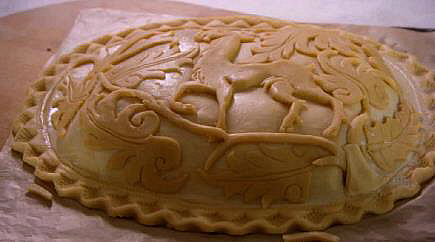

|
 Small pieces of venison in gravy, possibly with vegetables and other meats, in a pastry case. Although the term 'pasty' is used, the dish is now usually a dished or double-crust pie, rather than the folded-pastry modern pasty. "The neck, breast, and shoulder", says Eliza Leslie in her 1840 'Directions for Cookery, in its Various Branches', "are the parts used in a Venison Pasty".  Ivan Day's late medieval venison pasty (uncooked) Image: http://www.bbc.co.uk Venison Pasty must be one of the brightest icons of old-fashioned good-living there is, "A hero" says E Nesbit in 'The Wouldbegoods' "is always contented with a venison pasty and a horn of sack." Conan Doyle has his knight-heroes eat it, as does Walter Scott. Robin Hood, it would seem from his books, rarely ate anything else while Samuel Pepys records every venison-pasty (along with every flagon of wine and every pretty wench) which he had the good fortune to enjoy.  Original Receipt in 'The Queene-Like Closet' (1672) by Hannah Woolley (Wooley 1672) Original Receipt in 'The Queene-Like Closet' (1672) by Hannah Woolley (Wooley 1672)276. To make a Venison Pasty. Take a Peck of fine Flower, and three Pounds of fresh Butter, break your Butter into your Flower, and put in one Egg, and make it into a Past with so much cold cream as you think fit, but do not mould it too much, then roul it pretty thin and broad, almost square, then lay some Butter on the bottom, then season your Venison on the fleshy side with Pepper grosly beaten, and Salt mixed, then lay your Venison upon your butter with the seasoned side downward, and then cut the Venison over with your Knife quite cross the Pasty to let the Gravie come out the better in baking, then rub some seasoning in those Cuts, and do not lay any else because it will make it look ill-favoured and black, then put some paste rouled thin about the Meat to keep it in compass, and lay Butter on the top, then close it up and bake it very well, but you must trim it up with several Fancies made in the same Paste, and make also a Tunnel or Vent, and just when you are going to set it into the Oven, put in half a Pint of Clarret Wine, that will season your Venison finely, and make it shall not look or taste greasie, thus you may bake Mutton if you please.  Original Receipt from 'Savoury Pastries' by Frederick T Vine (Vine 1900) Original Receipt from 'Savoury Pastries' by Frederick T Vine (Vine 1900)No. 99.— Venison Pasty. Take a neck or breast of venison, or both, which are usually to be procured at small cost, and cut it up into neat, square pieces; season with salt, pepper, and a few spoonsful of the aromatic mixture No. 11 (see page 31). Put the whole of it into a large jar, the bones of the venison at the bottom, and place on top a few good slices of a fat breast of mutton; pour in a glass of red wine and a little water ; cover the mouth of the jar up with paper or a flour and water crust, and stand it at the mouth of the oven for a couple of hours. When done, arrange the pieces into a pie dish; fill up with the gravy; cover with a crust; decorate with leaves; wash over with egg; bake in a moderate oven, and serve, either hot or cold, with red-currant jelly.  |
|
MORE FROM Foods of England... Cookbooks ● Diary ● Index ● Magic Menu ● Random ● Really English? ● Timeline ● Donate ● English Service ● Food Map of England ● Lost Foods ● Accompaniments ● Biscuits ● Breads ● Cakes and Scones ● Cheeses ● Classic Meals ● Curry Dishes ● Dairy ● Drinks ● Egg Dishes ● Fish ● Fruit ● Fruits & Vegetables ● Game & Offal ● Meat & Meat Dishes ● Pastries and Pies ● Pot Meals ● Poultry ● Preserves & Jams ● Puddings & Sweets ● Sauces and Spicery ● Sausages ● Scones ● Soups ● Sweets and Toffee ● About ... ● Bookshop ● Email: [email protected] COPYRIGHT and ALL RIGHTS RESERVED: © Glyn Hughes 2022 BUILT WITH WHIMBERRY |